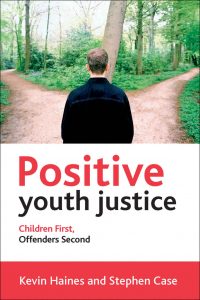After blogging on ‘negative’ youth justice, Professor Steve Case talks positive solutions in the follow up blog to his recent CYCJ seminar.
In my previous blog, Negative youth justice: Creating the youth crime ‘problem’, I offered a somewhat scathing and sceptical perspective on contemporary youth justice, particularly how youth offending (understood through a risk perspective) has become a political stick with which to beat children and young people.
It is my contention that the governmental youth justice project, until recent progressive developments (e.g. AssetPlus, enhanced diversionary mechanisms), has adopted an excessively negative focus and a micro-managed approach that has stifled practitioner creativity and artificially restricted explanations of youth offending and responses to ‘youth offenders’. It’s well worth re-reading my previous critical dissection of the Youth Justice System (YJS) to give you context for my subsequent arguments.
Even as an avowedly critical youth justice academic, I’m constantly shocked by the damaging, criminalising and dehumanising portrayal and treatment of children and young people who offend by contemporary youth justice systems; by the absence of foundational principles for practice and by the marginalisation of children and young people from youth justice processes. I’m even more shocked by the continued obsession with risk as a guiding concept for youth justice practice and by government belligerence and resistance to progressive and principled systemic change.
The suggestion (to me) is that risk assessment and intervention is a ‘no-brainer’ solution to the alleged youth crime problem, despite compelling international evidence that diversion, restorative justice and promotional interventions have a more substantive and sustainable impact on the extent and nature of youth offending and the quality of children’s lives.
Regardless of the wealth of contrary evidence (risk bad, positive approaches good, YJS succeeding in reducing first-time entrants and custody levels), the newer version of the new Conservative government (Theresa May as Prime Minister, Liz Truss as Justice Secretary) appears to want a newer version of the new Conservative approach to youth justice (new government, new idea – a recurring theme in youth justice). The Charlie Taylor review of the YJS commissioned by the Conservatives has been placed in stasis, as have the other progressive intentions of previous Justice Secretary, but notorious Brexiteer, Michael Gove (e.g. problem-solving courts, sweeping prison reforms). So, the new model is on hold until a newer new model can be identified.
My proposal, therefore, is for a radical reorientation of youth justice through a series of positive practice principles that coalesce to form a newer new model: Positive Youth Justice: Children First, Offenders Second. Positive Youth Justice (PYJ) is the solution to the youth crime ‘problem’ because it deproblematises and normalises offending by children and young people, viewing it as an everyday behaviour requiring supportive and appropriate responses. In other words, PYJ doesn’t treat youth crime as a new or growing problem, so doesn’t introduce methods that sustain and exacerbate it. Better still, PYJ is evidenced (tick!) and economical (double tick!), thus attractive to government and compelling for local authorities when the localisation/devolution agenda comes to pass.
What is Positive Youth Justice?
On April 1, 2000, Swansea Youth Offending Team (YOT) officially came into being under the Crime and Disorder 1998 (as did all other YOTs in England and Wales). On the same day, the organisation welcomed a fresh-faced, open-minded young PhD student from the local university, giving him an office and open access to all of their data, practitioners, young people, families and networks. Sixteen years, a couple of books and many research articles later, I’d like to tell you what that young researcher found at Swansea, across Wales and beyond on his journey to the cynical, opinionated professor that I am now!
In my view, Swansea practiced a distinctive form of youth justice that was underpinned by a local commitment to promoting positive behaviours and outcomes for young people through the strategies, programmes and projects of statutory and voluntary agencies (not just the YOT) and driven by an innovative and brave YOT manager called Eddie Isles. Further support for this approach came from an equivalent national (Welsh Government) commitment to promotional and entitlements-based social policy for children and young people and an evolving research relationship with Professor Kevin Haines (my then PhD supervisor and perennial mentor) who had developed the ‘children first’ principle of youth justice with Professor Mark Drakeford.
I was blessed with a confluence of positive circumstances. I became immersed in a highly progressive local youth justice context in a highly progressive national social policy context, guided by highly progressive youth justice professionals. Our University-YOT research partnership until the untimely retirement of Eddie Isles in 2012 provided experiences and produced evidence that enabled us to identify a coherent, progressive alternative model of youth justice. A subsequent working relationship with the ground-breaking Surrey Youth Support Service (YSS) and emerging dialogues with other forward-thinking youth justice service providers (e.g. Oldham. Kent, Bedfordshire) has offered further evidence of the effectiveness and impact of positive youth justice principles in practice.
The Positive Youth Justice model can be divided into five easy pieces – or rather, five clear principles for practice: children first, positive promotion, engagement, diversion and evidence-based partnership.
1. Children First
All youth justice practice should put children first, prioritising their status as a ‘child’ and its associated (limited) maturity, capabilities, abilities and power above any master status of ‘offender’ conferred by their behaviour. The United Nations Convention on the Rights of the Child defines a child as anyone below the age of 18, so by this measure, any ‘young offender’ is essentially a child – vulnerable, innocent (although degree of culpability is moot and variable across the 10 to 17 age range) and in need of support and protection by and from adults.
Whether they offend or not, children are not fully developed or empowered adults with the same cognitive, social and economic resources enjoyed by adults, so they should not be treated as such. Rather than ‘adulterising’ (treating as adults) and ‘responsibilising’ (held fully responsible for their actions) children who offend, youth justice responses should be child-friendly and child-appropriate. Offending behaviour by children should be seen as only one part of their much broader identity and so responded to in holistic, multi-agency and integrated ways (cf. the Scottish Whole Systems Approach), rather than dealt with in isolation by siloed, offender and offence-focused YOTs. Only then can those responses hope to be valid, meaningful and sustainable in the real lives of children and young people experiencing problems. Every other principle of positive youth justice practice links to and reinforces this children first, child-friendly commitment.

2. Positive Promotion
Youth justice strategy and practice should promote positive behaviours, outcomes, services and opportunities for all children in the youth justice system (and when they move beyond it) as priority, rather than pursuing a narrow focus on preventing risk-based negative outcomes. The positive, promotional approach is proven ‘effective’ practice (not always in the narrow governmental sense necessarily) for improving positive outcomes such as increasing access to rights/entitlements and participation in prosocial school and community activities.
Crucially, positive promotion can also reduce the negative outcomes prioritised by the dominant negative prevention and risk-focused form of youth justice (e.g. offending, reoffending, substance use, exposure to risk). Problematic offending-related issues are not ignored, but instead they are addressed in a principled, promotional, children first manner. Surrey YSS provides an evidenced application of child-friendly, integrated positive promotion through their substitution of AssetPlus with the Common Assessment Framework as a needs-led means of pursuing positive outcomes such as increased participation and engagement with education, training and skills development.
3. Engagement
Children are part of the solution to youth crime, not part of the problem. The much-neglected perspectives of practitioners can contribute further to this solution. Positive Youth Justice encourages practitioners and policy makers to work in partnership with these children to promote their interests, needs, rights and views as paramount throughout youth justice processes.
Positive Youth Justice moves practice beyond the deficit-focused model of negative youth justice (which can punish children who offend for their individual failings) and towards a more constructive, child-appropriate approach in which children are rewarded for their achievements. Consequently, adult practitioners view themselves as working with and for the children with whom they engage, rather than as representatives of other interest groups (for example, the YJS, community, victims). The priority for staff is to engage closely and regularly with children. This is the over-arching philosophy of most YOT practitioners anyway, so the PYJ model simply provides them with a coherent set of structures and principles to facilitate this goal.
It is crucial, therefore, that children who come into contact with the YJS are facilitated (by adult practitioners) to express their views on issues that affect them, enabled to participate equitably in decision making regarding their futures, and that access to their universal entitlements as set out in progressive policy statements and international conventions is promoted. These features coalesce to produce a model of delivering youth justice that can be viewed as legitimate to children (i.e. moral, fair, deserved, equitable), thus increasing the likelihood of them engaging with (investing in, believing in, committing to) the approach.
In this way, children’s engagement with youth justice practice and practitioners goes deeper than the fundamentals of voluntarism, trust, respect and fairness (although these remain essential building blocks of the engagement relationship) and moves towards more positive notions of partnership, reciprocity, investment and legitimate participation in decision-making processes.

4. Diversion
Children should be diverted out of the formal YJS and into positive, promotional and progressive interventions. Progressive diversion can promote positive outcomes by (adults) enabling children to access constructive activities and interventions that promote success, achievement, capacity-building and access to entitlements and support services.
Diversion can also stimulate reductions in negative outcomes (the measures by which YOT performance is assessed) such as entering the YJS for the first time, obtaining a criminal record, reoffending and reconviction, along with other indicators of collateral damage such as punishment, labelling and criminalisation. The effectiveness of progressive diversion has been evidenced by the Bureau model, which has now been rolled out across Wales, along with the impressive (system leading) reductions in first-time entrants into the YJS achieved by Surrey YSS.
The Bureau incorporates systems management (child-focused decision-making at all stages of the youth justice process); partnership between practitioners (e.g. police, youth justice staff, teachers), children and families during assessment (prolonged, holistic assessment process consulting with all relevant parties); and decision-making/sentencing and intervention planning. These shared processes emphasise the positive, promotional elements of consultation, agreement and legitimacy (fair, moral, justified treatment of children).

5. Evidence-based partnership
Responses to children in the YJS should be underpinned by genuine, engaging partnership working that is evidence-based. Partnership is critical to the success of preventing offending, and this needs to be evident at the strategic level and in practice and delivery.
The development and implementation of reflective child-friendly youth justice services and interventions should be guided by evidence-based partnership between children and their families (cf. the ‘Team Around the Child/Family’ model that is applied in many localities across the UK), youth justice practitioners, policy makers and academic researchers (cf. the work of Greater Manchester Youth Justice University Partnership. Such a meaningful partnership approach guards against the government predilection for privileging risk-based, pseudo-psychological, Americanised, offender-focused ‘what works’ approaches – what Rod Morgan (former chair of the Youth Justice Board) dubbed ‘programme fetishism’.
It seems obvious to me that instead of this obsession with off the shelf, fashionable programmes, effective youth justice should be developed in partnership with children, the very group that they are aimed at and targeted on. All too often children are seen as a problem to be fixed, rather than a resourceful part of the solution to their own circumstances.
Similarly, practitioners are cast as the fixers of the problem, but given insufficient space, time or tools to employ their expertise and discretion and to reflect on and enhance an innovative children first, positive practice. Therefore, the generation of evidence to inform and shape youth justice practice should be open-minded, reflexive and bottom-up, rather than restricted, prescriptive and top-down, developed in locally-sensitive partnership with children and other key stakeholders.
Conclusion: From negative to positive youth justice
The five easy pieces of Positive Youth Justice constitute five not so easy principles to employ in an everyday youth justice practice that is heavily managed, prescribed and directed by central government. However, the gathering pace of public service reform and the potential for local devolution of policy and practice (albeit more motivated by economic austerity and political expedience rather than child and practitioner focused principles) offers fresh hope that space is emerging for localised discretion and mediation of government directives. The local mediation of practice prescriptions to reflect certain principles of Positive Youth Justice is already evident and growing in many areas, although the wholesale (not piecemeal) adoption of the model and its inevitable break from statutory (negative) youth justice requirements is perhaps most developed in Surrey YSS.
The challenge for local youth justice remains one of negotiating the messy complexities of real life – reconciling a positive, principled and progressive practice agenda with entrenched government requirements to pursue prescribed prevention and risk agendas. The negotiation and reconciliation of the prescriptive negative with the progressive positive must also balance children first ways of working with statutory requirements to address victims’ needs to enhance public protection. Both of these foci necessitate and deserve bespoke practice supplementary and complementary to (but never instead of) child-focused responses. These agendas do not need to be in competition – they can be complementary.
Prioritising the child and children first principles across all youth justice practice will benefit children (obviously), families, communities, victims and the public through reduction (of first-time entrants, offending, reoffending, custody) and promotion (of positive, prosocial, sustainable behaviours and outcomes) – an evidence-based, effective practice model fit for the 21st century.
For further information and notification and future blogs, please visit www.profstevecase.com
Main picture: Professor Case presents his proposal for a new youth justice model

Leave a Reply
You must be logged in to post a comment.